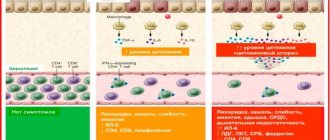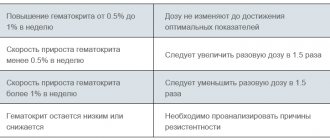Sandostatin
A synthetic derivative of the hormone somatostatin, which has similar pharmacological effects and a significantly longer duration of action. Reduces the secretion of growth hormone, TSH, has an antithyroid, antispasmodic effect. Reduces acid production and gastrointestinal motility. Suppresses pathologically increased secretion of growth hormone, peptides and serotonin produced in the gastroenteropancreatic endocrine system.
Normally, it reduces the secretion of growth hormone caused by arginine, stress and insulin hypoglycemia; secretion of insulin, glucagon, gastrin and other peptides of the gastroenteropancreatic endocrine system caused by food intake, as well as secretion of insulin and glucagon stimulated by arginine; secretion of thyrotropin caused by thyrotropin-releasing hormone.
Suppression of growth hormone secretion by octreotide (as opposed to somatostatin) occurs to a much greater extent than by insulin. The administration of octreotide is not accompanied by the phenomenon of hypersecretion of hormones through the “negative feedback” mechanism. In patients with acromegaly, it reduces the concentration of growth hormone and/or somatomedin A in plasma. A clinically significant decrease in the concentration of growth hormone (by 50% or more) is observed in almost all patients, while normalization of the content of growth hormone in plasma (less than 5 ng/ml) is achieved in approximately half of the patients.
For carcinoid tumors, the administration of octreotide can lead to a decrease in the severity of symptoms of the disease, primarily such as flushing of the face and diarrhea; clinical improvement is accompanied by a decrease in the concentration of serotonin in plasma and the excretion of 5-hydroxyindoleacetic acid in the urine.
For tumors characterized by overproduction of vasoactive intestinal peptide (VIP), a decrease in severe secretory diarrhea, which is characteristic of this condition, which in turn leads to an improvement in the patient’s quality of life. At the same time, there is a decrease in concomitant electrolyte imbalances, such as hypokalemia, which makes it possible to cancel enteral and parenteral administration of fluids and electrolytes. It is possible to slow down or stop the progression of the tumor and even reduce its size and especially liver metastases. Clinical improvement is usually accompanied by a decrease (down to normal values) in plasma VIP concentrations.
In glucagonomas, despite a marked reduction in the necrotizing migratory rash, it does not have any significant effect on the severity of diabetes mellitus (often observed in glucagonomas) and usually does not lead to a decrease in the need for insulin or oral hypoglycemic drugs. In patients suffering from diarrhea, it causes a decrease in it, which is accompanied by an increase in body weight; there is often a rapid decrease in the concentration of glucagon in plasma, but with long-term treatment this effect does not persist. At the same time, symptomatic improvement remains stable for a long time.
In gastrinomas (Zollinger-Ellison syndrome), octreotide, used as monotherapy or in combination with H2 receptor blockers and proton pump inhibitors, can reduce the formation of HCl in the stomach, possibly reducing the severity and other symptoms, probably associated with the synthesis of peptides by the tumor, incl. "tides". In some cases, there is a decrease in plasma gastrin concentration.
In patients with insulinomas, it reduces the concentration of immunoreactive insulin in the blood (this effect, however, can be short-term - about 2 hours).
In patients with operable tumors, it can ensure the restoration and maintenance of normoglycemia in the preoperative period. In patients with inoperable benign and malignant tumors, normoglycemia can be achieved without a simultaneous prolonged decrease in insulin in the blood.
In patients with rare tumors that overproduce growth hormone releasing factor (somatoliberinomas), it reduces the severity of symptoms of acromegaly. This appears to be due to suppression of the secretion of growth hormone releasing factor and growth hormone itself. In the future, it is possible to reduce the size of the pituitary gland, which was enlarged before treatment.
In patients with acromegaly, administration of octreotide provides, in the vast majority of cases, a persistent decrease in growth hormone and normalization of the concentration of insulin-like growth factor 1/somatomedin C (IGF1). Significantly reduces the severity of symptoms such as headache, increased sweating, paresthesia, fatigue, pain in bones and joints, peripheral neuropathy. In patients with pituitary adenomas that secrete growth hormone, a reduction in tumor size is possible.
Sandostatin is a long-acting dosage form of octreotide intended for administration at 4-week intervals to maintain stable therapeutic octreotide serum concentrations. The microspheres include a polymer matrix that serves as a carrier of the active substance. After intramuscular administration, as a result of the destruction of microspheres in muscle tissue, a long-term and gradual release of the active substance occurs.
Side effects
- Digestive system: often - diarrhea, flatulence, constipation, cramping abdominal pain; sometimes - cholecystitis; rarely – nausea, steatorrhea, bloating, vomiting, formation of gallstones; very rarely - loose stools, anorexia, acute pancreatitis, acute hepatitis without cholestasis, increased activity of liver transaminases, levels of alkaline phosphatase and gamma-glutamyltransferase, hyperbilirubinemia. The frequency of the described side effects can be reduced by increasing the intervals between Sandostatin administrations and meals;
- Cardiovascular system: sometimes – tachycardia and bradycardia;
- Endocrine system: very rarely - hyper- or hypoglycemia;
- Respiratory system: very rarely - shortness of breath;
- Dermatological and allergic reactions: sometimes - temporary hair loss; rarely – rash, hypersensitivity phenomena; very rarely - anaphylaxis;
- Local reactions: with subcutaneous administration - itching, burning, pain, redness and swelling at the injection site (usually disappear within 15 minutes). The severity of these reactions decreases when using a solution at room temperature or introducing a more concentrated solution, but in a smaller volume;
- Other: excretion of fat in feces.
There are very rare cases of acute pancreatitis, which developed in the first hours or days after subcutaneous administration of the drug and went away on its own after its discontinuation. With prolonged use, the development of pancreatitis associated with cholelithiasis is possible.
In rare cases, during the treatment period, thyroid dysfunction and dyspeptic symptoms are observed, and arrhythmias develop.
Possible changes on the ECG: early repolarization, deviation of the electrical axis of the heart, low-voltage type of ECG, prolongation of the OT interval, displacement of the transition zone, nonspecific changes in the T wave and ST segment, early P wave. Heart disease is observed in many patients with carcinoid tumors and acromegaly, therefore the cause-and-effect relationship between the development of the described phenomena and the use of Sandostatin has not been reliably established.
Contraindications
The use of Sandostatin is contraindicated in the presence of hypersensitivity to its components.
When prescribing the drug, caution must be exercised in the presence of the following diseases/conditions (relative contraindications):
- diabetes;
- cholelithiasis;
- period of pregnancy and breastfeeding (experience with therapy in this group of patients is limited, and therefore the doctor can prescribe therapy after assessing the benefit-risk ratio).
Rules for purchasing and storing funds
Since independent use of the drug is associated with a high risk to health and life, the sale of Sandostatin is strictly by prescription. For a package of 5 ampoules of 100 mgk you need to pay up to 2400 rubles. And when purchasing the Sandostatin Lar variety, the price increases to 27,000-33,000 rubles.
After purchasing, you should store the medicine in a place protected from the sun. It is worth taking care that the temperature in it is 2-8 degrees. A mandatory requirement is to protect the medicine from easy access by children. In this form, the purchased drug can be stored for up to three years, diluting the required amount of the product immediately before injection.
Rules for taking the drug
Since Sandostatin is a potent drug, its prescription is preceded by a number of diagnostic methods. So, before the therapeutic course, the patient needs to undergo a blood test and an ultrasound to check the condition of the abdominal organs, including the pancreas. During the treatment process, all these studies are periodically repeated. This allows you to control the effect of the medicine on the body.
Before use, an injection solution is prepared based on the active substance. Water or saline solution can be used as a solvent. The only prohibition is the use of glucose solution for this purpose. There are 3 methods of administering the drug into the body:
- subcutaneous;
- intramuscular;
- intravenously (including using a dropper) via intravenous routes.
Important. When choosing the time to use the drug, the choice falls on the intervals between meals, as well as the hours before bedtime. Thus, the risk of developing adverse reactions is reduced.
The minimum course of treatment with Sandostatin is 5-7 days. In this mode, recovery is carried out after surgery in which the pancreas was affected. In this case, the first dose of the drug is administered an hour before surgery. And then they continue to give injections according to the usual schedule. This way complications can often be avoided.
In severe forms of the disease, drug therapy is extended for several months. In this case, close monitoring of the patient’s condition is mandatory. If negative reactions to therapy occur, the course must be adjusted.
Drug interactions
The combined use of Sandostatin with certain drugs can lead to the development of the following effects:
- quinidine, terfenadine and other drugs with a narrow range of therapeutic concentrations, metabolized by the CYP3A4 isoenzyme: their metabolic clearance decreases (with combined use, caution is required);
- bromocriptine: its bioavailability increases;
- cyclosporine: its absorption decreases;
- cimetidine: its absorption slows down.
special instructions
Regular diagnosis plays an important role in the treatment of neoplasms in the gastrointestinal tract and cholelithiasis with Sandostatin. In this way, you can monitor the course of the disease, promptly detect worsening symptoms, and take quick measures. If these principles are followed, a lasting therapeutic effect can be achieved with minimal risk of relapse.
To avoid prolonged and pronounced hypoglycemia, it is worth administering the medicine frequently, but in small doses. To do this, you should use the time between meals and before bed. This will help stabilize the balance of sugar and glucose in the blood.
If it is not possible to use Sandostatin in a particular case, the doctor may decide to prescribe its analogues. These include Okeron, Octrin, Octride, Genfastat and others.





